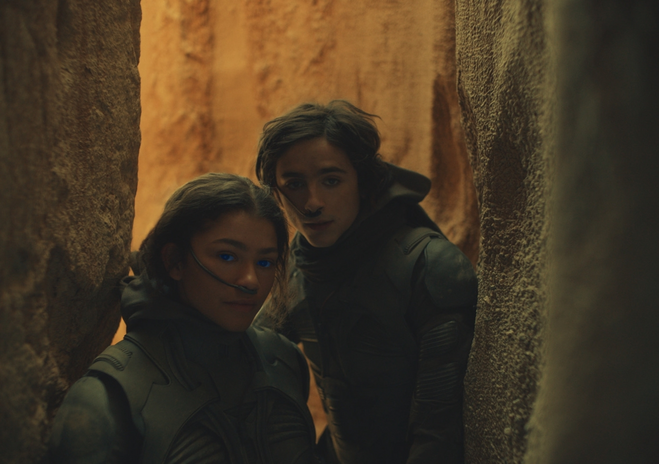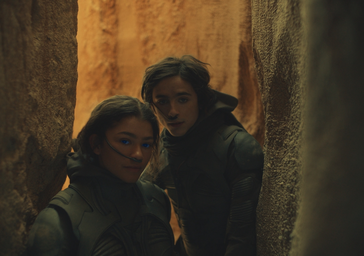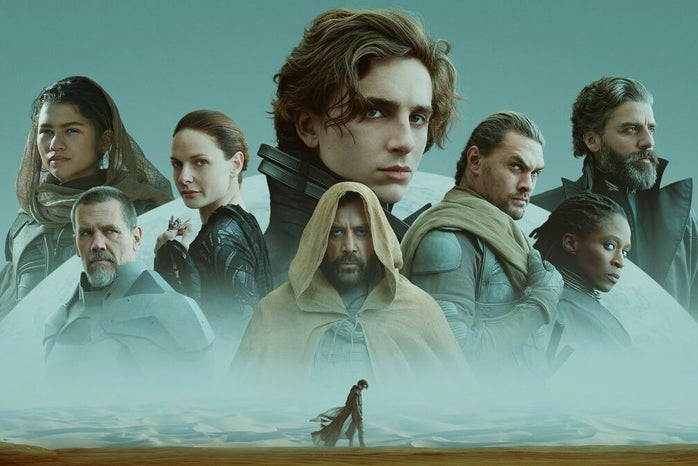Leaning closer to the book than has ever been done before, Villeneuve’s take on Dune exceeds cinematic expectations, presenting a visually aesthetic masterpiece enriched with fantastic performances from its Hollywood A-list cast.
From the moment Dune (2021) was announced, the whole world was stopped in its tracks and anxiously awaited the outcome of this film adaptation. Despite earlier failed attempts to capture the intricacies of Frank Herbert’s 1965 novel on the big screen, notably David Lynch’s ‘disowned’ 1984 version or John Harrison’s underwhelming 2000’s tv-series, Denis Villeneuve took the reins on this challenge and created an absolute masterpiece that redeems Herbert’s fictional universe, at last.
Set in the year 10191, the story follows the life of Paul Atreides (Timothée Chalamet), a brilliant young man of noble descent whose clairvoyant dream-like visions predict the downfall of the State. Son to the Duke of planet Caladan, Leto Atreides (Oscar Isaac) and Jessica (Rebecca Ferguson), a powerful and respectable member of the Bene Gesserit, a sisterhood who possess telekinetic abilities; Paul is born into a formidable destiny, appointed as ‘The Chosen One’ and expected to restore justice to the planetary system.
When his family are urged to move to Arrakis, the land of the giant sandworms and dunes, in order to aid ‘spice’ harvesting and production, the Atreides family find themselves in a metaphorical sinkhole that results in betrayal, death, and anguish. With no one left to trust, they have no choice but to flee their home and seek refuge in the desert; as Paul longs to find the Fremen, the natives of the desert, unaware that the girl who haunts his visions, Chani (Zendaya) is among them.
Villeneuve’s take on Dune leans closer to the novel of the same name than previous adaptations: in these two-hours-and-thirty-minutes, Villeneuve establishes the political and plot-driving foundations of the novel, capturing the first two-hundred pages or so, that really get the story started.
Could it be that Villeneuve’s cinematic success, then, lies in his accurate depiction of the novel, or is it merely a result of his immense directorial ambition and talent? I’m going to have to say both.
Earning over $304.6 million since its release in October, the film’s successes have been recognised worldwide, despite the contention of it being a two-part film. The film’s title sequence revealed that Dune (2021) was not in fact a stand-alone film, but one that would end in a ‘To Be Continued…’ cliff-hanger and would be divided into parts that are yet to come. Though many fans were happy about this directorial decision, following Warner Bros. recent announcement that its sequel, Dune: Part Two, is scheduled to be released in October 2023, many were unhappy and disappointed about the long wait.
Following the first film’s successes, however, it is undeniable that this was the right approach for the Dune cinematic universe. Viewing this film as an intended trilogy, as opposed to a stand-alone film that attempts to cram everything in, allows the viewer to immerse themselves in the narrative with ease and enjoyment instead of worrying about all the ground it has to cover- since Dune is one hell of a ride.
Though I’m not typically a fan of sci-fi, this film is definitely one to watch. It is enthralling from beginning to end, immersed with fantastic performances from its exceptional cast members, like Jason Momoa, Stellan Skarsgard, and Sharon Duncan-Brewster, who deserve honourable mentions for their performances.
Though, it is the astounding visuals that add a greater awe-inspiring depth to the film. Dune (2021) is masterfully shot, with the picturesque backgrounds and breath-taking cinematography that encapsulates the wonders of the desert partially stealing the show. Villeneuve’s attention to detail, exhibited in the film’s subliminal settings and backdrops, synthesised with its life-like CGI effects are highly commendable as they transport the viewer seamlessly into the ethereal world of Arrakis.
That being said, the film has received a lot of backlash for Zendaya’s lack of screentime. Though Zendaya’s character, Chani, permeated the trailer and advertisements, it is recorded that Zendaya appeared for no more than 7 minutes in the actual film.
This is undeniably a great marketing strategy, influencing viewers to enter the world of Dune (2021) and stay for the following instalments of the trilogy that will answer its questions, develop its characters, and unravel the political problems that ensue.
I simply cannot wait to see what else Villeneuve has in store for Dune, and I await Part Two, coming in 2023, with excitement and anticipation.





